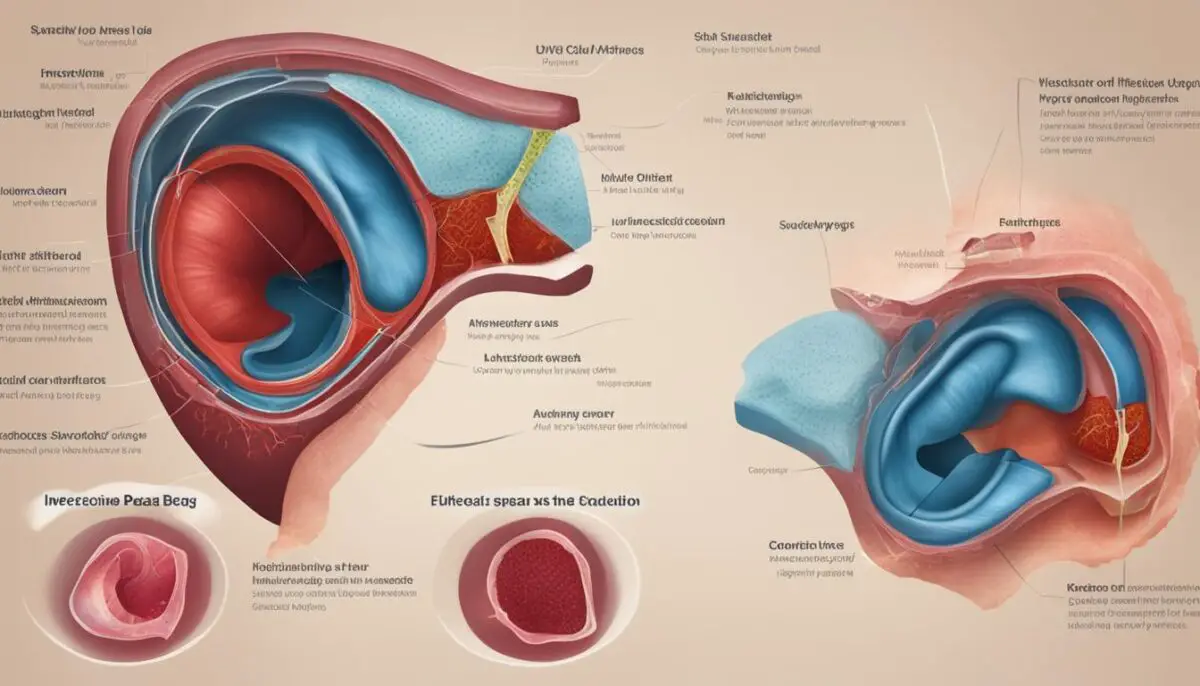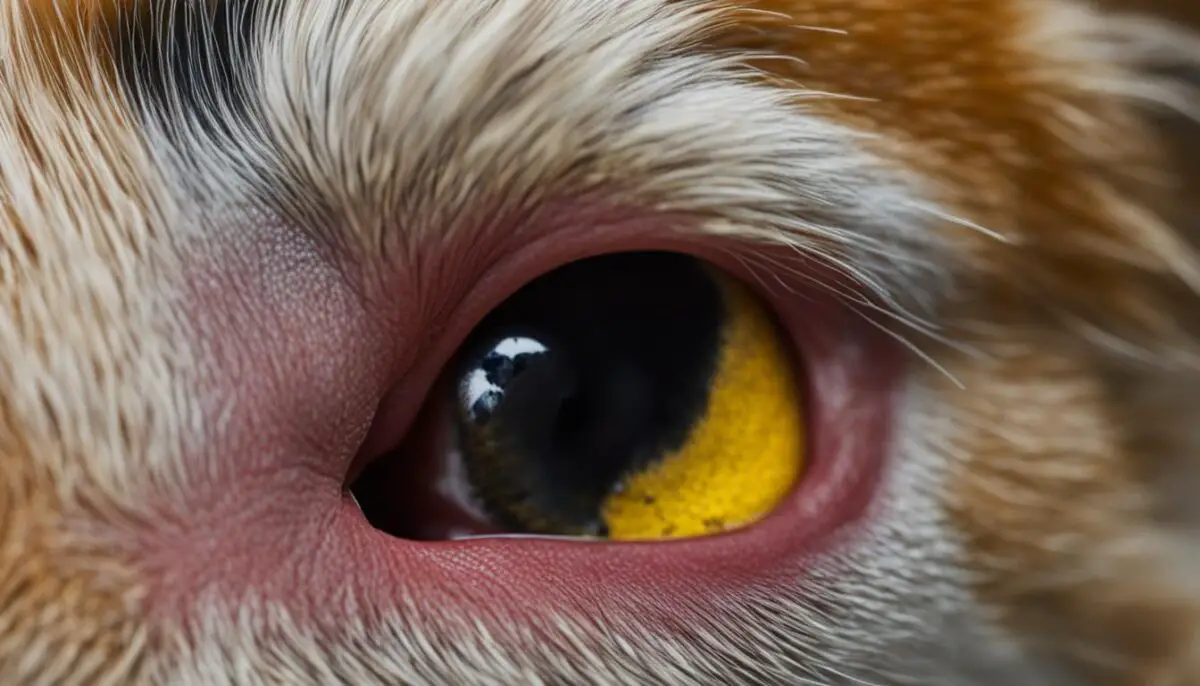Otitis interna is a common condition in dogs, characterized by inflammation of the inner ear. This inflammation is often caused by bacterial or fungal infections. Certain breeds, such as Cocker Spaniels and Basset Hounds, with their long and heavy ears, are more susceptible to chronic ear infections and otitis interna. If left untreated, these infections can lead to serious complications and discomfort for your furry companion.
The symptoms of an inner ear infection in dogs can vary, but some common signs to watch out for include a head tilt, balance problems, difficulty walking, and hearing loss. In some cases, your dog may experience pain or discomfort when chewing or pawing at their infected ear. If you notice any of these symptoms, it is important to consult a veterinarian for a proper diagnosis and treatment plan.
Treating a dog’s inner ear infection typically involves a combination of medication and home care. Your vet may prescribe antibiotics or anti-fungal drugs to combat the underlying infection. These medications can be administered orally or directly into the ear. In more severe cases, surgery may be necessary to drain the middle ear or remove the affected ear canal. It is crucial to follow your vet’s instructions and complete the full course of treatment to ensure a successful recovery.
To prevent inner ear infections in dogs, proper ear care is essential. Regular cleaning and drying of the ears can help remove excess moisture and prevent bacterial growth. Grooming is particularly important for dogs with long, floppy ears or narrow ear canals. By taking proactive measures to maintain your dog’s ear health, you can minimize the risk of infections and ensure their overall well-being.
Key Takeaways:
- Inner ear infections in dogs can be caused by bacterial or fungal infections.
- Common symptoms of a dog’s inner ear infection include a head tilt, balance problems, and difficulty walking.
- Treatment usually involves medication, such as antibiotics or anti-fungal drugs, and home care.
- Proper ear care, including regular cleaning and drying, can help prevent inner ear infections in dogs.
- If you suspect your dog has an inner ear infection, it is important to consult a veterinarian for proper diagnosis and treatment.
Causes of Dog Inner Ear Infection
Dogs can develop inner ear infections due to various causes. While bacterial infections are the primary culprit, yeast and fungi can also contribute to these infections. Additionally, ear mites, which can migrate from the outer ear to the inner ear, can lead to infection. Certain breeds with drooping ears and narrow ear canals, such as Beagles and Cocker Spaniels, are more prone to middle and inner ear infections. Other factors that can cause inner ear infections in dogs include foreign objects in the ear, trauma, and the presence of tumors or polyps.
A comprehensive understanding of the causes of dog inner ear infections is crucial for effective prevention and treatment. By addressing these underlying causes, pet owners can help their furry companions maintain optimal ear health.

(Note: The image above is only for illustrative purposes and does not directly represent the causes of dog inner ear infections.)
Signs of Dog Inner Ear Infection
Dogs with inner ear infections may exhibit a range of signs and symptoms. Being aware of these signs is important for prompt identification and treatment of the infection. Here are the common signs to look out for:
- Reluctance to chew: Dogs with inner ear infections may show a reduced appetite or avoid chewing on toys or treats.
- Head shaking: One of the most noticeable signs is excessive head shaking. If you notice your dog vigorously shaking their head, it may indicate an inner ear infection.
- Pawing at the affected ear: Dogs may paw at their ear in an attempt to alleviate discomfort caused by the infection.
- Head tilt: A tilted head, usually towards the side of the infected ear, is a common symptom of an inner ear infection. This can affect the dog’s balance and coordination.
- Balance issues: Dogs with inner ear infections may have difficulty maintaining balance. They may stumble, fall, or have trouble walking straight.
- Hearing loss: An inner ear infection can lead to temporary or permanent hearing loss in dogs. If you notice your dog not responding to sounds or commands they used to hear, it may be a sign of an infection.
In addition to these primary symptoms, inner ear infections can also manifest with various eye-related symptoms. These may include drooping eyelids and unusual eye movements, indicating a connection between the inner ear and ocular functions. It is important to observe any redness, discharge, or foul odor in the affected ear, as these can further confirm the presence of an infection.
By recognizing these signs, dog owners can seek appropriate veterinary care and provide the necessary treatment to alleviate discomfort and prevent complications.

Treating Dog Inner Ear Infections
Treatment for dog inner ear infections typically involves a combination of medication and home care. When seeking treatment for your furry friend’s ear infection, it’s important to consult with a veterinarian for a proper diagnosis and guidance.
Medications such as antibiotics or anti-fungal drugs are commonly prescribed to treat the underlying infection. These medications may be administered orally or directly into the ear, depending on the severity and type of infection. It’s essential to follow the veterinarian’s instructions regarding dosage and frequency for effective results.
In severe cases where the infection has spread or complications arise, surgical intervention may be necessary. Your veterinarian will determine if surgery is required to drain the middle ear or remove the entire external ear canal.
Dog Ear Infection Home Remedies
In addition to medication, there are home remedies that can complement the treatment of dog ear infections. However, it’s important to note that these remedies should always be used under the guidance of a veterinarian and should not replace prescribed medication or professional care.
“Natural remedies can provide temporary relief for mild ear infections, but it’s crucial to address the underlying cause with appropriate veterinary treatment.”
Some home remedies that may provide temporary relief include:
- Regularly cleaning the affected ear with a veterinarian-approved solution to remove excess wax and debris.
- Applying warm compresses to the infected area to help reduce inflammation.
- Using a veterinarian-approved ear cleaner to help maintain proper ear hygiene.
- Providing a balanced diet rich in essential nutrients to support your dog’s immune system.
- Ensuring your dog’s living environment is clean and free from potential irritants.
Again, it’s crucial to consult with a veterinarian before attempting any home remedies to ensure you’re taking the appropriate steps to address your dog’s ear infection effectively.
| Treatment Methods | Benefits |
|---|---|
| Medication prescribed by a veterinarian |
|
| Surgery (in severe cases) |
|
| Home care (under veterinarian guidance) |
|
It’s essential to continue the full course of treatment, as prescribed by your veterinarian, even if your dog’s symptoms improve. This will help prevent a relapse or recurrence of the infection.
Remember, timely and appropriate treatment is crucial for successful recovery and preventing potential complications associated with dog inner ear infections.
Conclusion
Preventing dog ear infections is crucial for maintaining your pet’s ear health. Regular cleaning and drying of the ears can help prevent moisture buildup, which can create an environment for bacteria to thrive. It is recommended to use a veterinarian-approved ear cleaner to gently remove debris and excess wax.
Proper grooming is also essential, especially for dogs with long, floppy ears or narrow ear canals. Regularly trimming the hair around the ears can help improve airflow and reduce the risk of infections. Additionally, checking and cleaning your dog’s ears after swimming or bathing can help remove any trapped water or moisture.
If your dog shows signs of an ear infection, such as redness, discharge, or a foul odor, it is important to seek prompt veterinary care. A veterinarian can diagnose the underlying cause of the infection and prescribe appropriate medication. Following the veterinarian’s treatment plan and completing the full course of medication is crucial to prevent relapses and further complications.
By taking proactive measures to prevent and address ear infections, you can help keep your four-legged friend happy and healthy. Regular care and monitoring of your dog’s ears, along with timely veterinary intervention when needed, will ensure their overall well-being and reduce the risk of long-term ear problems.
FAQ
What are the symptoms of a dog inner ear infection?
The symptoms of a dog inner ear infection may include head tilt, balance problems, difficulty walking, hearing loss, and eye-related symptoms such as drooping eyelids and unusual eye movements. Dogs may also show signs of reluctance to chew, head shaking, pawing at the affected ear, and a head tilt to the side of the infected ear. Other signs can include redness, discharge, and a foul odor in the affected ear.
What are the causes of dog inner ear infections?
Dog inner ear infections can be caused by bacterial, fungal, or yeast infections. Other factors such as ear mites, foreign objects in the ear, trauma, and tumors or polyps can also contribute to inner ear infections.
How can I treat my dog’s inner ear infection?
The treatment for dog inner ear infections typically involves a combination of medication and home care. Your veterinarian may prescribe antibiotics or anti-fungal drugs to treat the underlying infection, which can be administered orally or directly into the ear. In severe cases, surgery may be necessary. Home care may include restricted activity, hand-feeding, and regular cleaning of the affected ear.
Can I treat my dog’s inner ear infection at home?
While some home remedies and over-the-counter treatments may provide temporary relief, it is crucial to consult a veterinarian for proper diagnosis and treatment of a dog inner ear infection. They can prescribe the appropriate medication and provide guidance on home care to effectively treat the infection and prevent complications.
How can I prevent dog ear infections?
Preventing dog ear infections is important for maintaining your pet’s ear health. Regular cleaning and drying of the ears can help prevent moisture buildup, which creates an environment for bacteria to thrive. Proper grooming and care for dogs with long, floppy ears or narrow ear canals can also reduce the risk of infections. If you notice any signs of an ear infection, prompt veterinary care is essential for effective treatment and prevention of complications.

